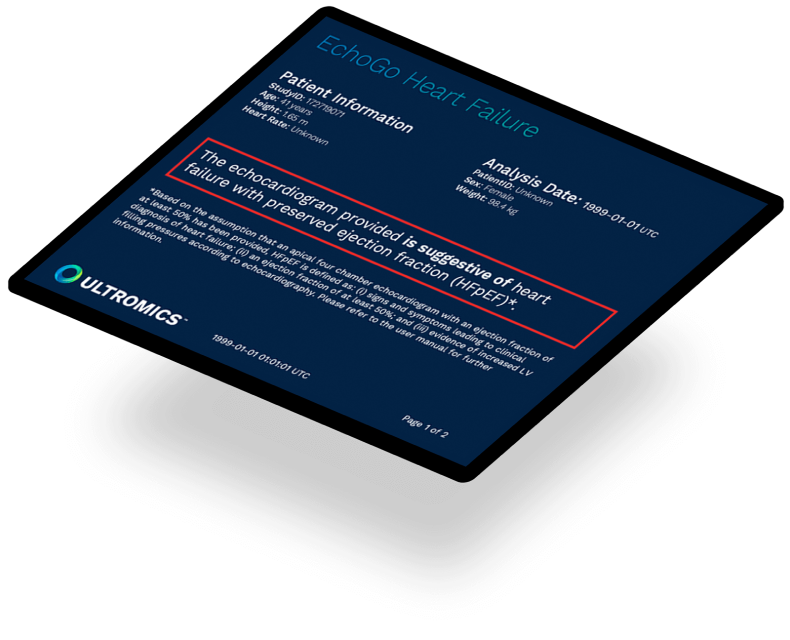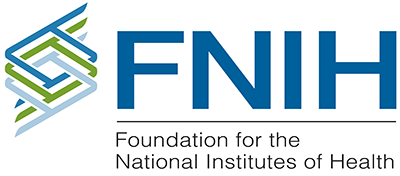A new class of heart failure technology
HFpEF detection
Ultromics brings the power of artificial intelligence into your echocardiography workflow using a state-of-the-art platform that supports early heart failure diagnosis. EchoGo Heart Failure unlocks a new pathway for heart failure care, bringing patients closer to a definitive diagnosis, accelerating earlier diagnosis and treatment, and helping to improve the lives of many.
Score
Score
Heart Failure
Compared to current clinical algorithms, EchoGo Heart Failure resulted in an accurate diagnostic output for more patients, and successfully identified patients with worse 5-year survival.4
The beat of change
A first-of-kind solution
Detect HFpEF with precision from a single apical four-chamber echocardiogram view.
Using our FDA-cleared system, our platform has helped clinicians solve indeterminate cases and helped providers reduce costs.

increase in accuracy4
Improved detection of HFpEF with fewer indeterminates4
See our proof and validation
See moreVerified in clinical settings
Our current customers have indicated major improvements in their pain and process while using EchoGo Heart Failure. Our technology is backed by collaborations with industry leading clincians, engineers, and research institutions.
“This novel solution applies AI to cardiovascular imaging to greatly simplify identification of patients with HFpEF, a diagnosis that can be challenging to make, and allow more expeditious treatment.”
Time to focus on HFpEF
Diagnosis is challenging
Currently, diagnosis relies on a combination of symptomatology and echocardiographic evidence and the exclusion of non-cardiac causes of dyspnea according to clinical scores. This complexity is a challenge, and up to to 64% of patients are missed a diagnosis3, leading to unavoidable invasive hemodynamic measurements and missed treatment.

Key issues are preventing progress
“Julian, 81, presented symptoms of shortness of breath and oedema, but had undetermined results when his diastolic function was assessed.”
AI capabilities
Any vendor
Connects with any vendor in any care setting.
Dashboard
Customer report dashboard and smart analytics.
QC + secured
CyberEssentials, ISO 27001, and ISO 13485. HIPAA Compliance.
No training
No need to learn software. Always being optimized.
Seamless
Simple and easy integration that fits with your workflow.
Cloud native
Operate on a cloud native architecture for optimal resource saving.
Together with experts
Each of our partners are innovation leaders are working with us to make lives better.
We partner with exceptional leaders across all stages to build transformative technologies.
Some of who we work with






Our impact across heart failure
“The FNIH will harness valuable perspectives and expertise of a select number of collaborations, including Ultromics, to alleviate this unmet need and pave the way for better classification and more precise treatment strategies.”
We are redefining heart failure as we know it
Innovation is at the heart of everything we do
At the heart of our mission is a commitment to making heart failure detection easier for providers and prognosis better for patients. Healthcare professionals should receive critical information they need minimizing the added risks and costs of untreated patients or further procedures. Staying true to the standards set by our Oxford University origins, we are partnering with the most trusted and validated medical organizations in the world to improve quality of life and reduce the burden on the healthcare system at large.
100,000+
cases processed so far
10,000+
pixels analyzed by our AI algorithm
10 years
of outcome data
Curious about upcoming research and innovation?
Sign-up to hear about the latest news.
[1] Gerber Y, et al. A contemporary appraisal of the heart failure epidemic in Olmsted County, Minnesota, 2000 to 2010. JAMA Intern Med. (2015) 175:996–1004. [2] Savarese G, Lund LH, et al. Global public health burden of heart failure. Card Fail Rev. 2017;3(1):7-11. [3] Barry A. Borlaug, et al. Heart Failure With Preserved Ejection Fraction: JACC Scientific Statement. J Am Coll Cardiol. 2023 May, 81 (18) 1810–1834. [4] Akerman, A.P., et al. ACC, 2023, Comparison of clinical algorithms and artificial intelligence applied to an echocardiogram to categorize risk of heart failure with preserved ejection fraction.
*based on an example use case.
Curious about upcoming research and innovation?
Sign-up to hear about the latest news.



